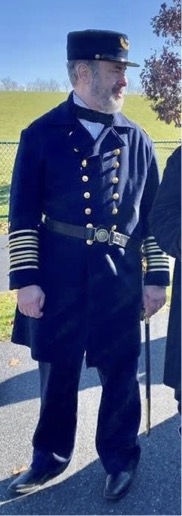
Born on June 8, 1813 in Chester, PA, David Dixon Porter was the son of famed U.S. Navy Commodore David Porter. Five years earlier his father adopted the orphaned James (later David) Glasgow Farragut, who would also become one of the great Union naval commanders of the Civil War.
David Dixon Porter joined the navy at age 16 In 1829 as a midshipman.
He served in the Navy in the decades leading up to the Civil War performing a wide variety of duties. These included serving as a junior officer on warship sent abroad, extensive work with the U.S. Coast Survey Service in charting America’s coasts and riverways, and other special missions such as the transport of camels from the Mediterranean that were used in the creation of the U.S. Army’s experimental camel corps.
Porter distinguished himself during the Mexican-American War through his audacious bombardment of the Mexican coastal defenses at Vera Cruz, and his successful capture of the interior Mexican town of Tabasco through personally leading sailors on a land-based attack. Commodore Matthew Perry commended Porter for his actions and rewarded him with his first command, the “Spitfire,” a sidewheel steamer.
Despite his accomplishments, Porter was only a Lieutenant at the outbreak of the Civil War, but he quickly caught the attention of President Lincoln due to his daring relief of Fort Pickens on the Gulf Islands of Florida. Soon after that successful mission, Porter was promoted to Commander. In the months to come Porter would play a key role in providing fire support to his step-brother David Farragut’s successful capture of New Orleans in April 1862.
Porter’s persistence and ingenuity in pressing the attack against the Confederacy, led Union Secretary of the Navy, Gideon Welles (with President Lincoln’s blessing), to give Porter command of the Union’s Mississippi flotilla, and advance him to the rank of Acting Rear Admiral. In that role, Porter worked closely with Generals Grant and Sherman in developing and executing the plan that led to the capture of the Confederate stronghold of Vicksburg, MS. This victory gave the Union full control of the Mississippi and earned Porter a promotion to permanent Rear Admiral.
Throughout the rest of the Civil War, Porter led many major naval operations such as the Red River Campaign and the attacks on Fort Fisher. His capture of Fort Fisher in Wilmington, NC, closed the last major port of the Confederacy.
After the War in 1865, Porter was appointed the Superintendent of the U.S. Naval Academy. He instituted widespread reforms that modernized the Academy’s curriculum and infrastructure and added an honor code and other methods for enhancing discipline. He was also an instrumental force in influencing the development of the post-Civil War navy.
After the death of his step-brother, Admiral Farragut in 1870, David Porter would ultimately be the second person to be appointed to this highest of ranks. Admiral Porter remained on active service until his own death at the age of 77, in February 1891.
Brad Stone

Brad Stone portrays Admiral Porter for COUG.
In addition to his participation in COUG, Brad volunteers as a docent on a regular basis at both the National Museum of Civil War Medicine in Frederick, MD and aboard the U.S.S. Constellation in Baltimore Harbor.
He also gives presentations on a variety of Civil War topics at a many of venues. These include institutions like the Gettysburg Heritage Center in Gettysburg, PA; the Clara Barton Missing Soldiers Office Museum National Park in Washington, DC; the Antietam National Battlefield Park in Antietam, MD; and the U.S. Navy Museum at the Navy Yard in Washington, DC.
In addition, several of his talks have been nationally televised on C-SPAN3 American History TV.